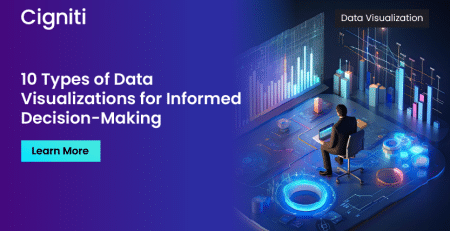5 Proven Practices to Get Effective Data Visualization
Today, every business gathers a sizable quantity of data. From app usage statistics to repeat purchases stats, from time spent on the app to the location of buyers, almost every data point is collected and stored in databases.
We all know the importance of data in the growth of a business. From stocking inventory in anticipation of demand to focusing on more profitable customers and areas, and optimizing employee productivity, data gives us accuracy. But it is helpful in the growth of our business only if we can draw insights from it and make better decisions.
Why do businesses need data visualization?
Businesses required a means to quickly and easily acquire an overview of their data as they gathered enormous quantities of data in the early years of the big data movement. Tools for visualization fit in naturally.
Graphical depiction of information and data is known as data visualization. By using visual components like charts, graphs, and maps, data visualization tools make it simple to explore and grasp trends, outliers, and patterns in data. These tools and technologies are critical in the big data environment to analyze enormous volumes of data and make data-driven decisions.
Effective data visualization is a decisive step in data analysis; key insights and messages are lost without it. Bad data visualizations cause audiences to misinterpret the true data, leading to poor business decisions. As a result, it is critical to always keep the best practices in mind when creating visualizations.
Using visual data, data visualization offers a rapid and efficient approach to conveying information to all audiences. Additionally, the practice can help businesses in determining the variables that influence consumer behavior, identify areas that require improvement or additional attention and make data more memorable for stakeholders. This also helps in finding out the best times and locations to sell particular products, and forecast sales volumes.
Best practices for effective data visualization
How can you tell if your data visualizations are making your message as clear and impactfully as possible? Is your visualization making your ideas simpler to understand, or is it so cluttered that your message is lost?
In this blog, we’ll provide you with five best practices for improving the effectiveness of your data visualizations along with specific illustrations of typical errors. By putting these best practices into exercise, you may improve the message of your visualization and make the case for action or change based on the data stronger.
5 best practices to get data visualization right:
- Knowing the audience
- Using the right type of chart
- Using the right set of text and labels
- Keeping simple and clear visualization
- Being careful with colors
1. Knowing the audience
Keep your audience in mind when researching the data and developing your final data visualizations. What information do they need? What matters to them? What other queries do they have that you might address with your visualization or a different perspective? How does your visualization meet the needs of your audience?
Narrow the objective of the visualization and be aware of the audience it will affect, whether it is for you or an internal or external audience. Your data research and data presentation should be guided by this.
When choosing various data sets to examine, deciding how to compare various data categories, or constructing the final visualization and determining what finishing touches to add, having a clear objective can help you know where to start.
Building visualizations and assembling them into a dashboard is not a method of giving customers access to data. There’s a potential that one won’t fit everyone. More effort must be put in than simply comparing performance with others; we must also watch behavior and measure effectiveness.
2. Using the right type of chart
Your data story will either benefit or suffer as a result of the sort of chart you employ. There may be a variety of useful charts, therefore it’s important to be extremely clear about your data visualization’s objective and target audience because they may both influence which chart is most appropriate.
The kind of data visualization you should produce will be significantly influenced by how data-literate your audience is. A more sophisticated chart, such as a chord diagram, may be useful and convey a great deal of information to an audience with high data literacy.
However, if your audience is unable to read that kind of chart, your argument will be missed, and you could have done better to just compare the figures side by side.
Consider the fact that some charts are inherently less successful at effectively presenting the information. Pie charts are not advised since the human brain cannot compare two rectangles, as in a bar graph, to rapidly determine the area of an angled item. Viewers won’t be able to compare differences if pie chart parts are too tiny.
In addition, it might be difficult to read bubble charts or tree maps accurately since they employ area rather than height. We advise utilizing a straightforward bar graph or histogram if the user needs to compare multiple data sets in a clearer, more precise manner.
3. Using the right set of text and labels
Text may either support your argument or clutter the page and take attention away from it. Labels, a one-sentence description, a title, a legend, etc. are all examples of text that may be found in data visualizations. Text is always used to clarify the meaning of the visualization, never to draw attention away from the data.
When labeling your data visualization, having too many or too enough labels may cause problems. Take a step back from the visualization and consider whether it is visually simple to read based on the placement of the labels. How many labels are too many? Consider what material you have emphasized the most by seeing it as if it were the first time. When you read a label, which one first leaps out at you?
Label the visualization with specific values if that is required. However, if the audience doesn’t need to know an exact figure for comparative purposes, you may remove it and let them read the axis instead.
4. Keeping simple and clear visualization
You must choose carefully what you portray at a time when there is so much information available. Remove from your visualization anything that doesn’t support the message of the data. Feel free to eliminate something if it doesn’t further the message or relate to the visualization’s purpose.
Remove any information that won’t be understood by your audience. Does your audience understand what it means? Do they want to know more about it or do they have a question? Include it in your graphic if they should have a query about it. There is no need to include it if not.
Avoid adding too many unnecessary design components. To make your representation or your idea more fascinating, you don’t need to use more design components. Have faith that the data’s argument is convincing enough. If your audience has to analyze extraneous design elements visually, they will take longer to read the visualization.
5. Being careful with colors
This is one of the most significant best practices for dashboard design. When it comes to color, there is an option of staying true to the company’s identity, for example- the same colors, logo, or fonts. Experimenting can also be done with a completely alternative palette. The crucial thing is to keep things consistent and avoid using too many distinct colors.
One can explore with gradients after selecting two to three colors. Most colors should always be toned down. Across all charts, we should utilize the same color for matching items. As a result, consumers’ amount of mental work is reduced, making dashboards more understandable.
Conclusion
An effective data dashboard should be visually appealing. It should be balanced and astute while remaining simple, accessible, user-friendly, and targeted to the goals and the audience. It should always be tried to develop a nice and tidy dashboard that aids visitors in gaining better comprehension of facts and aids in decision-making.
At Cigniti, we make data visualization an essential component of the reporting process and provide decision-makers with the drill-down and filtering choices they need to swiftly find the answers to their operational problems.
Cigniti is ready to help you with data visualization and value extraction to enhance your decision-making, to know more visit Cigniti Digital Engineering.





Leave a Reply